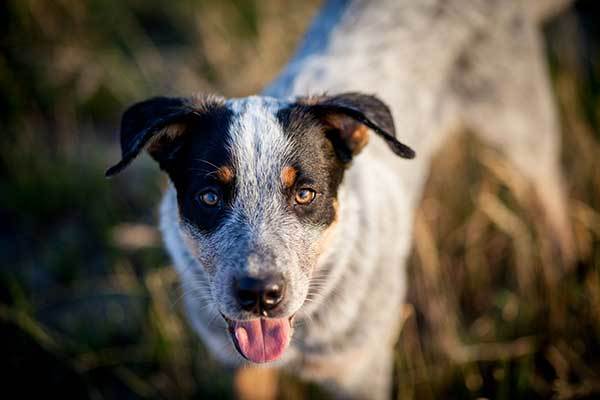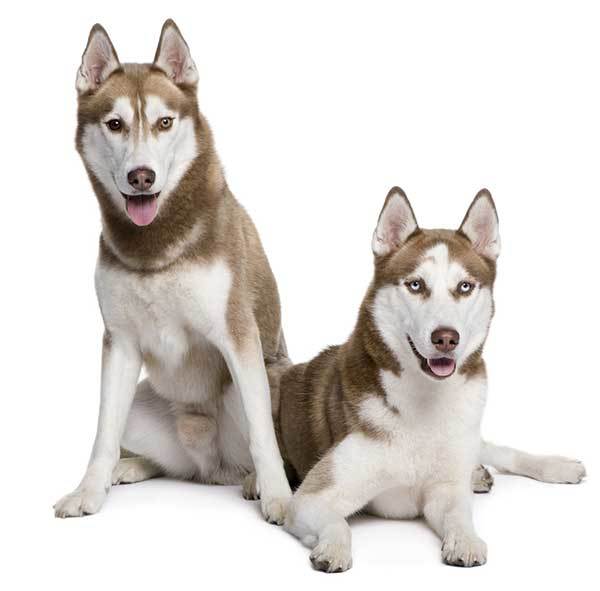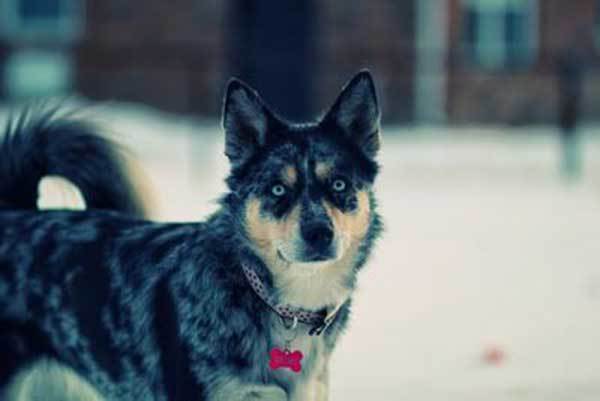There are many online pictures of the Blue Heeler Husky mix that immediately highlight the beauty of the dog.
However, new owners can’t buy on looks alone.
This dog, also known as the Australian Cattle Dog Husky mix isn’t the ideal family dog.
In this guide we will look at important info on the temperament and physical traits of this Blue Heeler Siberian Husky mix.
This means a closer look at the behavioral problems, grooming and exercise needs, as well as their potential as working dogs rather than family pets.
From there will will discuss the issue of the Ausky and confusions over breeding. We will also look at where to get a Blue Heeler Husky mix puppy.
Few Facts About the Blue Heeler Husky Mix
| Other names: | Ausky |
| Weight: | 40 to 60 pounds |
| Height: | 18 – 24 inches long |
| Lifespan: | 11 to 15 years |
| Apartment living: | No, do well in a home with a large backyard |
| Tolerate being alone: | No, suitable for active families |
| Coat: | Thick double coat |
| Level of shedding: | Moderate to High, brushing at least once or twice per week is required, daily brushing during shedding season |
| Temperament: | Stubborn, independent, smart, aggressive, protective, hardworking, energetic, lively |
| Suitable for new owners: | No |
| Exercise needs: | High, at least 1 to 2 hours of exercise a day is required |
| Dog and Cat friendly: | No, early socialization is required |
| Kids friendly: | No, Suitable for families with older kids, socialization is required |
| Price: | $600 to $1400 |
Who are the Parent Breeds?
The Ausky is a cross between two of the most hardworking dog breeds around: The Blue Heeler (also called the Australian Cattle Dog) and the husky.
If you’re considering adding this designer dog to your family, it is important to learn more about both of his parents’ breeds so that you get a good understanding of what physical characteristics and personality traits he could inherit.
Below, we’ll briefly look at the history and personality traits of each parent breed in order to get a clearer understanding of what to expect from your new mixed breed dog.
Blue Heeler Dog
As a breed, the Blue Heeler originated in the harsh climatic conditions of the Australian Outback and was commonly used as an aid in livestock herding.
A wide variety of breeds were used in the early stages of developing the Australian Cattle Dog. That said, as you’ll notice, this dog is a crossbreed in itself.
The early stock that was used in developing the breed included:
Smithfield: a sturdy herding dog that originated in the British Isles.
Dingo: these Australian wild dogs were used to boost endurance.
Blue Smooth Coated Highland Collies: these dogs were added in the 1840s by NSW cattle farmer Thomas Simpson Hall to modify the otherwise loud and aggressive Heelers.
Bull Terrier: these dogs were used in the 1870s to enhance stockiness.
Dalmatian: the Dalmatian was added to increase the love of cattle and loyalty to their owners.
Kelpie: the Australian Kelpie was added to instill a good work ethic and the tan markings characteristic of Blue Heelers today.
The Australian Cattle Dog is extremely intelligent and can solve problems on the move. He can also be stubborn because of the tenacity necessary to herd challenging cattle.
They also tend to be possessive and some can be aggressive towards other dogs. Therefore, proper socialization is a must for your Blue Heeler Mix dog.

Husky
The Siberian Husky is classified as a working dog. Known for his stamina, speed and intelligence, the Siberian Husky was originally used for pulling sleds.
This dog was also used as a family dog, often helping to keep the children of the nomadic people of Chuckchi warm in the cold winter conditions of the northeastern part of Siberia.
During the hotter, summer months, Siberian Huskies were left to hunt alone and this high prey drive is evident in the breed today.

So what should you expect when you mix these two different breeds? Let’s find out below.
This Blue Heeler and Husky mix can exhibit some behavioral issues
Many breeders like to find calmer dogs where they can tone down the primal traits of the Husky.
This isn’t quite so likely with this mix as the cattle dog can have some issues when untrained.
Untrained Heelers are aggressive and protective in the wrong way. Well trained heelers are loyal, friendly companions. There is also the risk of them herding small children in the family.
The Husky side does allow for more friendly, outgoing personality traits, but also stubbornness and independence.
The Husky Heeler as a working dog rather than a family dog
This Husky Blue Heeler mix temperament means they are often better off as a working dog.
This comes down to a combination of factors:
✔ There are those behavior issues that could be an issue around children.
✔ The high activity level of the dog is also a challenge, but makes them ideal for long hours on farms and ranches.
✔ Then there is the intelligence and desire to put their skills to good use. They do well as herding dogs, have the potential to pull sleds and are also great in agility.
✔ The other issue is the high impulse to wander in both parent breeds. This is an issue in family homes with unsecured boundaries.
Training A Siberian Husky Blue Heeler mix
This all means that these dogs need a good training regimen, whatever the situation.
The good news here is that both parent dogs are pretty smart and will learn very quickly, even if their stubborn side kicks in from time to time.
You should also make training a Blue Heeler Husky Mix an enjoyable experience and use lots of positive reinforcements in the form of food treats and verbal complements.
If you notice that your pooch is herding any member of your family, then you should try and discourage this behavior as soon as possible.
Since he is very intelligent, the Blue Heeler Husky should be able to pick up his training fast, and if not, simply be patient and consistent with your training methods and you will achieve the desired results sooner rather than later.
They will do well with a strong, dominant pack leader and consistent regimens. But, they also need positive reinforcement with everything from leash training and barking to housebreaking. This isn’t the easiest mix breed to train.
Proper socialization helps to eliminate the desire to herd children and other pets. It will also help ensure that your puppy grows up into a well-behaved dog who is confident in different situations.
Those that struggle will find guidance in the step-by-step solutions from Doggy Dan the Online Dog Trainer.
This intelligence and work ethic also means that they may benefit from mental simulation through interactive dog toys and the Brain Training for Dogs program from braintraining4dogs.com.
Coat and grooming issues with this Husky and Blue Heeler mix
There should be a thick double coat on this cross breed. This is great for colder climates, but not so much in hotter ones.
This means that the Husky Blue Heeler is not a hypoallergenic breed. During the shedding season, it’s recommended to brush his coat every day to keep it free of tangles and dead hair.
You can expect a reasonable amount of shedding, so invest in a furminator and keep up with vacuuming as required.
There is a mixture of colors here too. There are some paler dogs, depending on the color of the Husky, but also plenty of mottled tri-color merle coats from the genes of the heeler.
Bathing should be done only if he gets particularly dirty. Bathing him too frequently could make his skin dry. A good option is to use quality deodorizing wipes for dogs to keep his skin properly conditioned at all times.
It is also important to trim your dog’s nails each month. Overgrown nails are likely to crack or split, leading to pain or discomfort.
Also, make sure to brush your dog’s teeth regularly to prevent bad breath, tooth decay and gum disease. Dogs with clean and healthy mouths live happier and longer lives.
Exercise Needs
The Husky Australian Cattle Dog Mix is a high-energy dog who loves to stay active as well as play around throughout the day.
This cross is just as active as his parents, so be sure to provide him with the necessary physical exercises as well as the mental stimulation he needs to remain happy and healthy.
Ideally, you should be physically active yourself and have a proper daily exercise routine in place. This dog loves various physical activities.
The minimum amount of exercise your Husky Blue Heeler Mix will need is one to two hours each day.
Although taking your dog out for daily walks is highly recommended, he will also need to play and run around to release his limitless energy.
If you have a fenced-in yard, then allow your dog to run and play around it and also play games with him to help them burn off any excess energy. Playing games like Fetch and Frisbee with your dog is a good idea.
If these pups don’t get enough exercises, they are likely to get bored and start chewing on your carpet and furniture. You can keep your belongings safe by providing your Husky Blue heeler Mix with plenty of chew toys to ensure mental stimulation if you happen to leave him alone for long periods of time.
What Does a Husky Blue Heeler Mix Look Like?
How big will a Blue Heeler Husky mix get?
Most dogs will have a larger build and height than the heeler, but are more stocky than the Husky.
This is a good muscular build that allows for a dog with good stamina and energy levels.
The height is around 18-24 inches and the weight is 40-60 pounds.
There are sure to be pointed, erect ears and there is the potential for different colored eyes.
Diet & Feeding
These dogs require 2 to 3 cups of high quality dog food each day. They also need to be fed two to three times each day to remain happy and healthy.
Do not give him treats too often, as these can increase the risk of obesity. Treats should not exceed 10% of your pup’s daily diet.
For a healthy skin, and a smooth and shiny coat, invest in a kibble formula rich in Omega-3 and Omega-6 fatty acids.
Nonetheless, chances are your dog’s food is still not complete when it comes to nutrients.
That’s why it’s best to supplement your dog’s diets with vitamins and supplements. One of the best choices is Alaskan Salmon Oil, which is packed with Omega-3 fatty acids, necessary to keep your dog’s coat and skin healthy.
To improve the health of your dog’s liver and kidney, add probiotics to his diet as well. Also, frozen carrots make great chew toys for dogs while helping to improve their dental health. Moreover, carrots are a great source of vitamin A, fiber and potassium.
Giving your dog fresh water is also important as it helps to digest food and absorb the nutrients while keeping your pet cool and hydrated at all times.
Issues with breeding Ausky dogs
There is some confusion over the term Ausky. Ausky can refer to two different mixes:
The first is the Australian Cattle Dog and Husky, which is our Husky heeler mix. The other is the Australian Shepherd Dog and Husky mix.
There are physical traits that distinguish the two, such as the shape of the ears and the build of the dog. However, this isn’t always entirely clear when puppies are young.
This leads to two potential issues with finding a true Husky Heeler dog:
The first is dealing with breeders that promise a Blue Heeler Husky mix for sale, but actually have Husky Shepherd.
This is where it is important to ask to meet the parents first. Meeting the parents also allows new owners to learn more about the traits their new puppies may inherit as they grow up.
The other issue is with adoption. Shelters with Ausky dogs for adoption may not have a true idea of what they have. It could be an as yet undetermined Husky Aussie mix. This is where DNA tests, such as the Embark Breed Identification Dog DNA Test, can help.
These DNA tests are also helpful for highlighting any potential genetic health issues with these dogs.
Health Problems & Lifespan
They are generally a pretty healthy hybrid with a lifespan of 11-15 years. There are some risks of spondylosis, elbow dysplasia, and arthritis.
New owners also need to be aware of the high weight gain potential of heelers, which may be passed onto the offspring of this dog.
This means feeding them a good diet of the right dry dog food in adequate portions, and being careful with treats.
If you want to buy a puppy, choose a reputable breeder who will produce health clearances for both parent dogs.
ALSO READ: Your Complete Guide to The Blue Heeler Border Collie Mix
Is this Aussie Heeler Husky mix right for your needs?
There are plenty of positive traits here that mean that these mixes are great working dogs. The Husky Blue Heeler mix size, stamina and trainable nature are great for farms and other disciplines.
The behavior issues, grooming and stubbornness means they aren’t so good with families.
The Blue Heeler Husky mix is beautiful, but requires research and understanding. Be careful when buying Ausky dogs, learn about the parents and prepare for some hard work.
Featured Image Credit: Source


